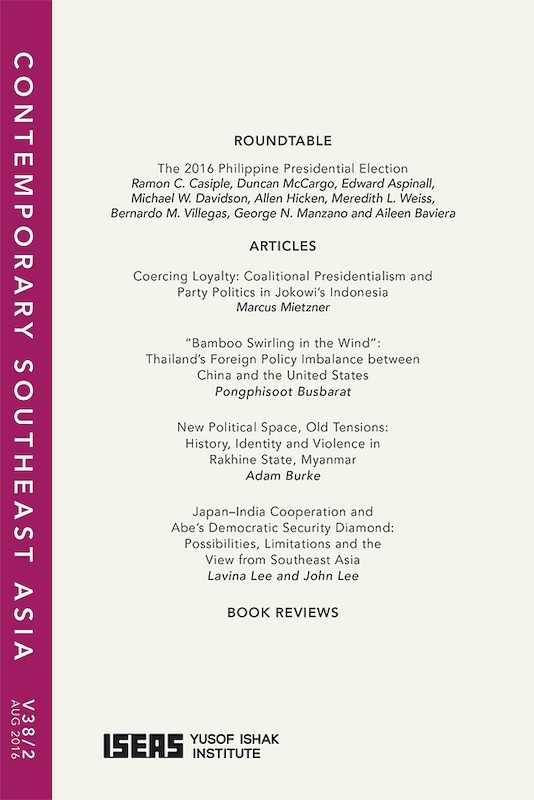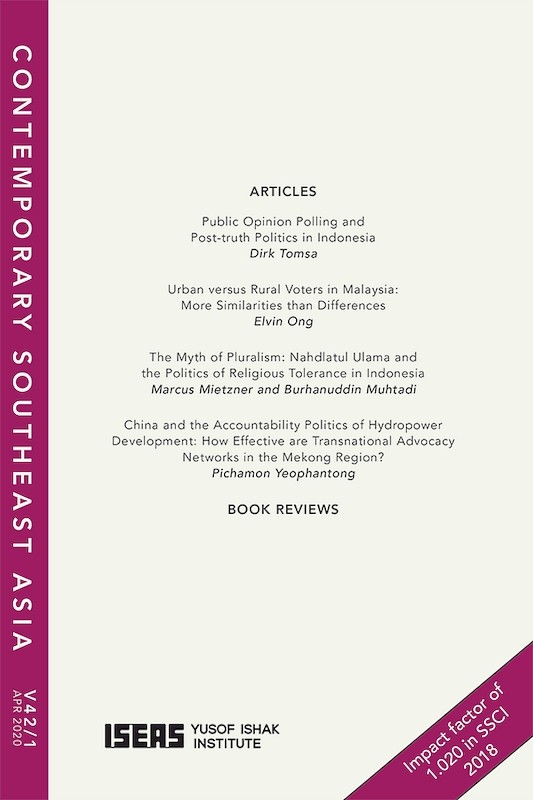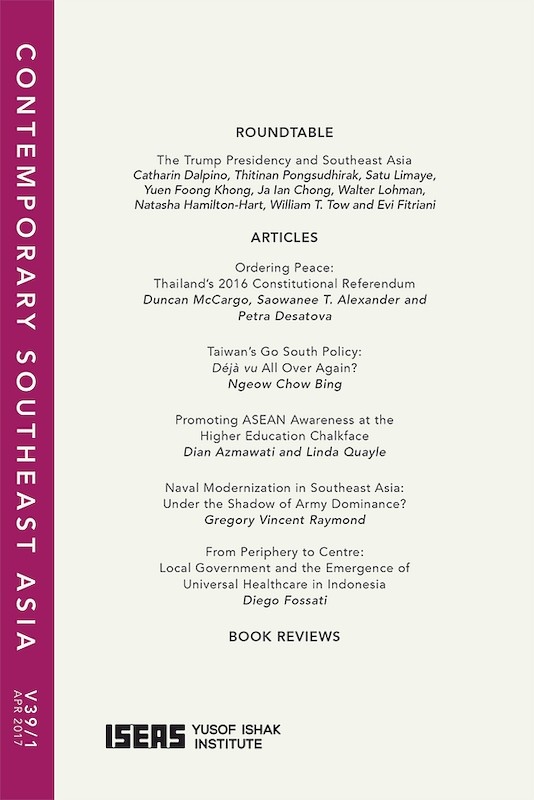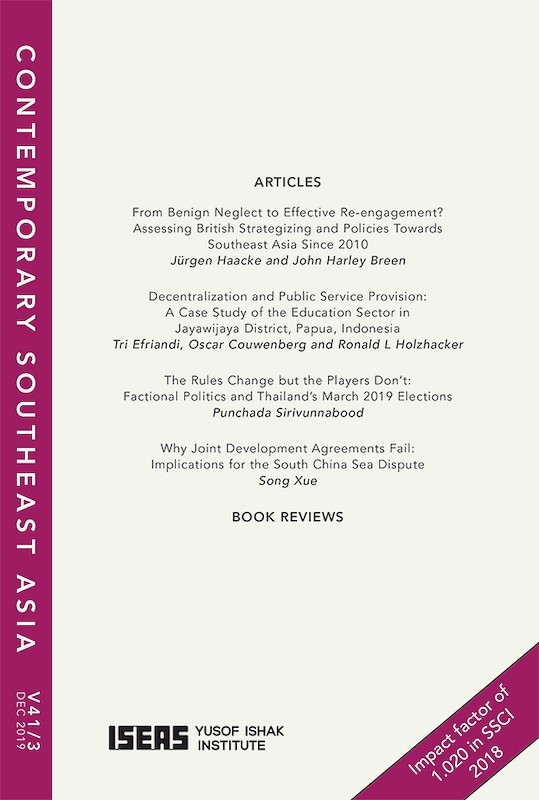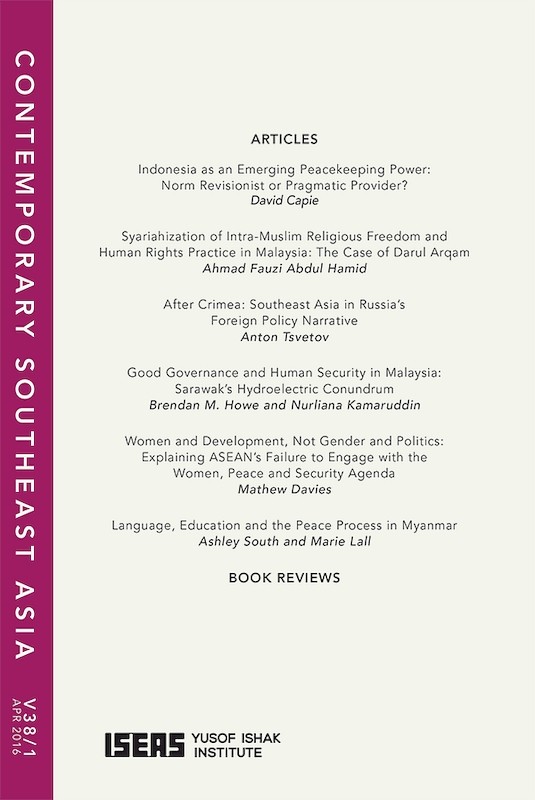Contemporary Southeast Asia Vol. 41/2 (August 2019)
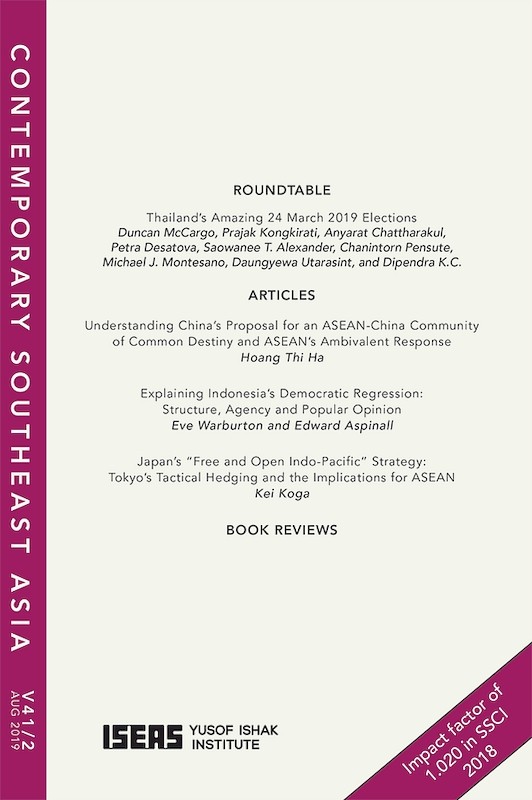
Ian Storey, editor
Date of publication:
August 2019
Publisher:
ISEAS – Yusof Ishak Institute
Number of pages:
176
Code:
CS41/2
About the publication
- Attained impact factor of 1.020 in Social Sciences Citation Index 2018
- Ranked 18th by Google Scholar Metrics 2018 in the Asian Studies and History category
Contents
-
Contemporary Southeast Asia Vol. 41/2 (August 2019)
[Whole Publication, ISSN: 1793284X] -
Preliminary pages
- ROUNDTABLE
-
1. Roundtable: Thailand’s Amazing 24 March 2019 Elections, by Duncan McCargo, Prajak Kongkirati, Anyarat Chattharakul, Petra Desatova, Saowanee T Alexander, Chanintorn Pensute, Michael J Montesano, Daungyewa Utarasint, Dipendra K C, authors
- ARTICLES
-
2. Understanding China’s Proposal for an ASEAN-China Community of Common Destiny and ASEAN’s Ambivalent Response, by Hoang Thi Ha, author see abstractThis article examines the rationales and manifestations of China’s vision for an ASEAN-China Community of Common Destiny (CCD). It argues that the ASEAN-China CCD proposal signals the crystallization of a deliberative and invested Chinese strategy for the future of ASEAN-China relations. This strategy aims to reinforce the ongoing power shift in Southeast Asia and engineer a smooth transition to a China-centred regional order against the backdrop of a perceived decline in US influence in the region. In this process, some predilections towards the pre-modern Sino-centric hierarchical regional system have resurfaced as China seeks to renegotiate the normative content of the regional order, and condition ASEAN member states into “good behaviours” accordingly. The article also examines the limits of the CCD concept in ASEAN-China relations as manifested by ASEAN’s ambivalent and selective responses. The ASEAN-China CCD vision injects a sense of determinism about the inevitability of the intertwined destiny between China and ASEAN member states, using geography, history and Chinese economic power as its basis. However, these push factors could also be burdens in an asymmetrical relationship which structurally induces ASEAN member states’ constant fear of over-dependency and loss of autonomy. The article therefore argues that the ASEAN-China CCD will not be a linear trajectory as ASEAN and most of its member states, while continuing to deepen cooperation and engagement with China, will persistently pursue open regionalism and perpetuate multi-polarity in Southeast Asia.
-
3. Explaining Indonesia’s Democratic Regression: Structure, Agency and Popular Opinion, by Eve Warburton, Edward Aspinall, authors see abstractAfter almost two decades of praise for Indonesia’s democratic achievements, a scholarly consensus has begun to emerge that Indonesian democracy is in regression. In this article, we consider the sources of that regression. Drawing upon the comparative literature on democratic decline, we propose that Indonesia is an illiberal democracy, and argue that a constellation of structural, agential and popular forces has led to an incremental deterioration in democratic quality. We first reaffirm arguments that trace the origins of contemporary democratic weakness to the nature of Indonesia’s transition, and the incorporation of anti-democratic elites into the governing structures of its democracy. We then show how Indonesia’s two most recent presidents each eroded democratic norms and institutions in pursuit of political security. Finally, we cast a critical eye on the widely shared view that Indonesia’s population is a bulwark of democratic strength. While most Indonesians support democracy as an abstract concept, significant parts of the population show limited support for the protections, checks and freedoms that underpin a liberal democracy. We suggest there is a significant constituency for illiberalism in Indonesia, and point to the presence of a conducive electoral environment for further democratic erosion.
-
4. Japan’s “Free and Open Indo-Pacific” Strategy: Tokyo’s Tactical Hedging and the Implications for ASEAN, by Kei Koga, author see abstractThis article argues that by creating a “Free and Open Indo-Pacific Strategy” (FOIPS) in 2016, Japan has engaged in “tactical hedging” to cope with the strategic uncertainty engendered by China’s growing economic power and political influence in Asia and the Trump administration’s uncertain foreign policy towards the region. Tactical hedging refers to a declaratory policy doctrine that aims to utilize temporal strategic ambiguity to understand and determine whether any long-term strategy shift is necessary or possible. In doing so, Japan has bided its time in order to understand strategic trends and coordinate policies and principles with allies and partners—especially the United States and ASEAN—and shaped the concept of a “Free and Open Indo-Pacific” (FOIP) in accordance with those consultations since 2016. Nevertheless, the emerging trend—especially the clear division between America’s more hardline stance towards China and ASEAN’s own conceptualization of the Indo-Pacific which aims to facilitate cooperation with China—indicates that the benefits of tactical hedging are diminishing, and that Japan needs to clarify its political stance if it wants to maintain its own FOIP concept as a viable strategic vision.
- BOOK REVIEWS
-
BOOK REVIEW: Indonesia: Twenty Years of Democracy, by Jamie S. Davidson, by Michael Vatikiotis, author
-
BOOK REVIEW: Power Broking in the Shade: Party Finances and Money Politics in Southeast Asia, by Wolfgang Sachsenröder, by Risa J Toha, author
-
BOOK REVIEW: Civil-Military Relations in Southeast Asia, by Aurel Croissant, by Adhi Priamarizki, author
-
BOOK REVIEW: Cambodia: Return to Authoritarianism, by Kheang Un, by Sivhuoch Ou, author

